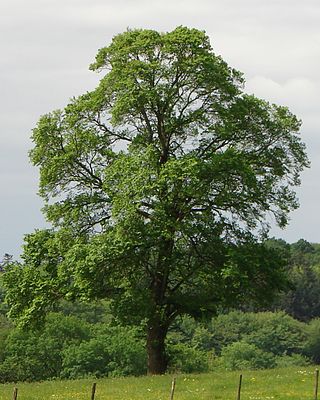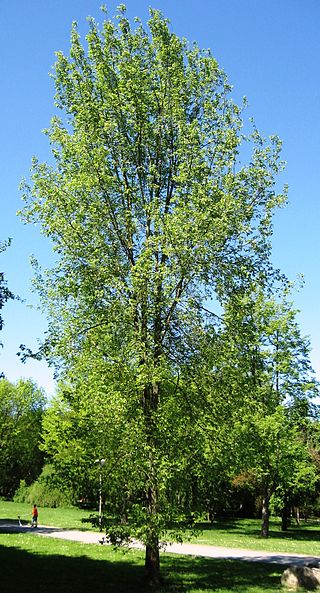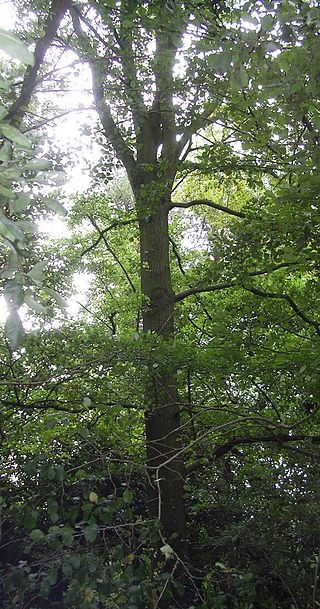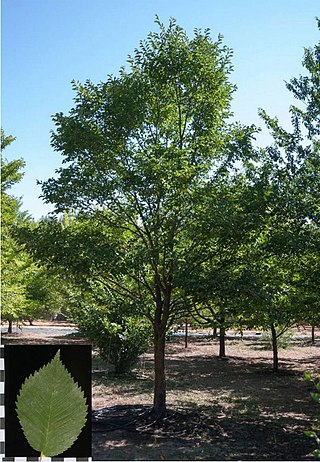Related Research Articles

Ulmus pumila, the Siberian elm, is a tree native to Asia. It is also known as the Asiatic elm and dwarf elm, but sometimes miscalled the 'Chinese elm'. U. pumila has been widely cultivated throughout Asia, North America, Argentina, and southern Europe, becoming naturalized in many places, notably across much of the United States.

Ulmus davidiana var. japonica, the Japanese elm, is one of the larger and more graceful Asiatic elms, endemic to much of continental northeast Asia and Japan, where it grows in swamp forest on young alluvial soils, although much of this habitat has now been lost to intensive rice cultivation.

Ulmus 'Nanguen' is a complex fourth generation Dutch hybrid cultivar raised at the Dorschkamp Research Institute for Forestry & Landscape Planning, Wageningen. Lutèce was derived from the cross 'Plantyn' ×, an ancestry comprising four field elms, a wych elm, the curious Exeter Elm ('Exoniensis'), and a frost-resistant selection of the Himalayan elm.

Ulmus 'New Horizon' is an American hybrid cultivar raised by the Wisconsin Alumni Research Foundation (WARF), from a crossing of the Japanese Elm clone W43-8 = 'Reseda' with Siberian Elm clone W426 grown from seed collected from a street tree at Yankton, South Dakota. As selection 'W917' it is a sibling of 'Rebona'. Tested in the US National Elm Trial coordinated by Colorado State University, 'New Horizon' averaged a survival rate of 74% after 10 years. 'New Horizon' was patented in the US in 1994, while in Europe, it is marketed as one of the 'Resista' elms protected under EU breeders' rights.

Ulmus minorMill., the field elm, is by far the most polymorphic of the European species, although its taxonomy remains a matter of contention. Its natural range is predominantly south European, extending to Asia Minor and Iran; its northern outposts are the Baltic islands of Öland and Gotland, although it may have been introduced by humans. The tree's typical habitat is low-lying forest along the main rivers, growing in association with oak and ash, where it tolerates summer floods as well as droughts.

Ulmus 'Regal' is an American hybrid elm cultivar developed by the University of Wisconsin–Madison and released in 1983. 'Regal' was derived from seeds arising from the crossing of the Dutch hybrid clones 'Commelin' and '215' sent in 1960 by Hans M. Heybroek of the Dorschkamp Research Institute for Forestry & Landscape Planning, Wageningen, Netherlands.

Ulmus 'Sapporo Autumn Gold' is one of the most commercially successful hybrid elm cultivars ever marketed, widely planted across North America and western Europe, although it has now been largely supplanted by more recent introductions. Arising from a chance crossing of the Japanese elm and Siberian elm, seed was sent in 1958 by Prof. Nobuku Takahashi and his colleagues at the Sapporo Botanical Garden of Hokkaido University, Sapporo, to Eugene Smalley at the University of Wisconsin–Madison. The patent issued in 1975 has expired, and there are now no propagation restrictions. However, the tree has proven weak-wooded on maturity, and its popularity has waned in Europe as a consequence of susceptibility to wind damage.

Ulmus 'Urban' is an American hybrid elm cultivar selected from the progeny of a controlled crossing of the Siberian Elm Ulmus pumila with the Dutch clone '148' in 1958 by Toru Arisumi of the USDA at Columbus, Ohio. Clone '148' had been sent to the US from the Netherlands in 1952 by Johanna Went, leader of the elm research team at the Willie Commelin Scholten Phytopathology Laboratory in Baarn.

Ulmus 'Wanoux' is a Dutch hybrid cultivar raised at the Dorschkamp Research Institute for Forestry & Landscape Planning, Wageningen, from an open pollination of 'Plantyn'. Originally identified as clone No. 762, it was selected for assessment by the French Institut National de la Recherche Agronomique (INRA), which patented it as 'Wanoux' in 2006.

Ulmus 'Cathedral' is a hybrid cultivar raised at University of Wisconsin–Madison patented in 1994. Arising from a chance crossing of the Japanese elm and Siberian elm, seed was sent in 1958 by Prof. Nobuku Takahashi and his colleagues at the Sapporo Botanical Garden of Hokkaido University, Sapporo, to Eugene Smalley at Wisconsin–Madison; 'Cathedral' is thus a sibling of 'Sapporo Autumn Gold'.

Ulmus 'Patriot' is a hybrid cultivar raised by the United States National Arboretum in 1980. Derived from a crossing of the American hybrid 'Urban' with the Wilson's Elm cultivar 'Prospector', 'Patriot' was released to commerce, free of patent restrictions, in 1993. Tested in the US National Elm Trial coordinated by Colorado State University, 'Patriot' averaged a survival rate of 85% after 10 years.

Ulmus 'Recerta' is an American hybrid cultivar raised by the Wisconsin Alumni Research Foundation (WARF) as selection '196-5' from seed obtained from a Siberian Elm Ulmus pumila in Volgograd, Russia; the male parent deduced as the Field Elm Ulmus minor.

The field elm cultivar Ulmus minor 'Ademuz' was cloned by root cuttings from a tree assumed to be growing in or near the eponymous town 100 km north-west of Valencia, Spain. The tree was discovered in 1996 by Margarita Burón of the Escuela Técnica Superior de Ingenieros de Montes, Universidad Politėcnica de Madrid (UPM). 'Ademuz' is one of a number of U. minor clones found to have a very high resistance to Dutch Elm Disease, on a par with, if not greater than, the hybrid cultivar 'Sapporo Autumn Gold' grown as a control. In the Madrid study, the appearance of the tree was rated 4.5 / 5, the most attractive of the seven selected cultivars.

The field elm cultivar Ulmus minor 'Dehesa de Amaniel' was raised from seed collected in 1999 from a tree growing in the Dehesa de la Villa park, within the Moncloa-Aravaca district of north-west Madrid by researchers at the Escuela Técnica Superior de Ingenieros de Montes, Universidad Politėcnica de Madrid. 'Dehesa de Amaniel' is one of a number of Spanish Ulmus minor found to have a very high resistance to Dutch Elm Disease, on a par with, if not greater than, the hybrid cultivar 'Sapporo Autumn Gold'.

The Field Elm cultivar Ulmus minor 'Dehesa de la Villa' was cloned by root cuttings from a tree growing in the eponymous park within the Moncloa-Aravaca district of north-west Madrid, by researchers at the Escuela Técnica Superior de Ingenieros de Montes, Universidad Politėcnica de Madrid in 1990.

The field elm cultivar Ulmus minor 'Majadahonda' was cloned by grafting scions from a tree found growing in the suburb of Majadahonda, 16 km north-west of Madrid, by researchers at the Escuela Técnica Superior de Ingenieros de Montes, Universidad Politėcnica de Madrid in 1993. The tree is one of a number found to have a very high resistance to Dutch Elm Disease, on a par with, if not greater than, the hybrid cultivar 'Sapporo Autumn Gold'. In the Madrid study, the appearance of the tree was rated 4.1 / 5.

The cultivar Ulmus 'Fuente Umbria' was raised from seed collected in 1995 from an elm resembling Ulmus minor growing in a field at Fuente Umbria west of Valencia, by researchers at the Escuela Técnica Superior de Ingenieros de Montes, Universidad Politėcnica de Madrid. 'Fuente Umbria' is one of seven cultivars found to have a very high resistance to Dutch Elm Disease, on a par with, if not greater than, the hybrid cultivar 'Sapporo Autumn Gold'. However, retrospective DNA analysis has revealed that the clone has Ulmus pumila DNA, the species introduced to Spain at the end of the 16th century, and has consequently been dropped from the programme.

The Field Elm cultivar Ulmus minor 'Retiro' was raised from seed collected in 2002 from a tree growing in the El Retiro park, in the centre of Madrid by researchers at the Escuela Técnica Superior de Ingenieros de Montes, Universidad Politėcnica de Madrid.

The elm cultivar Ulmus 'Toledo' was raised from seed collected in 1999 from a tree believed to be Ulmus minor growing in the eponymous city, by researchers at the Escuela Técnica Superior de Ingenieros de Montes, Universidad Politėcnica de Madrid. However, retrospective DNA analysis revealed that the clone also had Ulmus pumila DNA, the species introduced to Spain at the end of the 16th century, and has consequently been dropped from the research programme.
References
- 1 2 Santamour, Frank S.; Bentz, Susan E. (May 1995). "Updated Checklist of Elm (Ulmus) Cultivars for use in North America". Journal of Arboriculture. 21 (3): 122–131. Retrieved 20 June 2016.